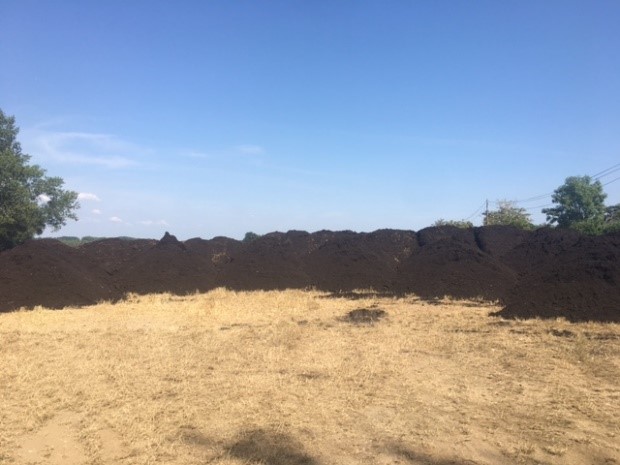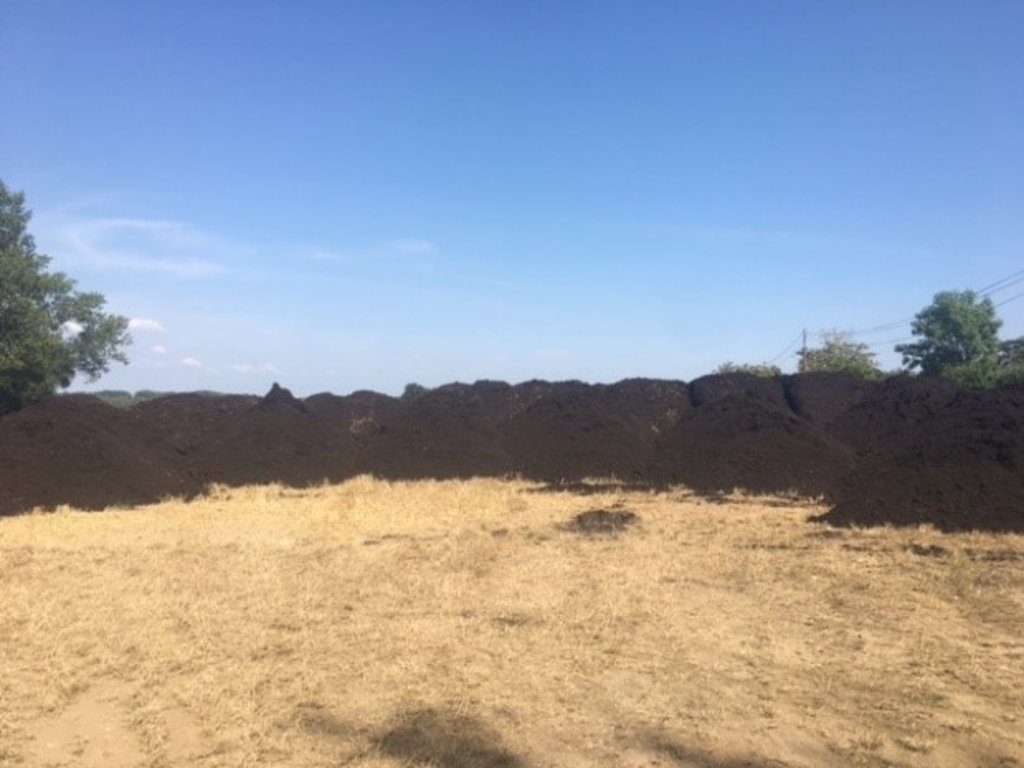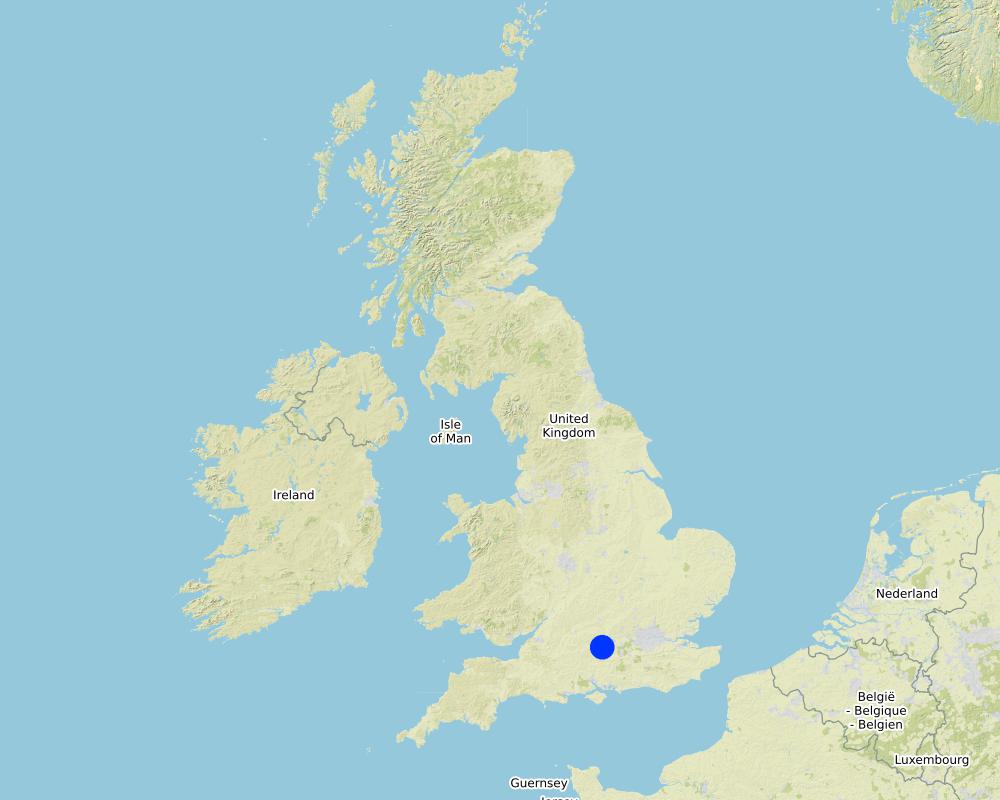Organic matter application to enhance soil health [United Kingdom]
- Creation:
- Update:
- Compiler: Alan Radbourne
- Editor: –
- Reviewers: William Critchley, Rima Mekdaschi Studer
technologies_5968 - United Kingdom
View sections
Expand all Collapse all1. General information
1.2 Contact details of resource persons and institutions involved in the assessment and documentation of the Technology
Key resource person(s)
land user:
Fisher Karen
Soil Association
United Kingdom
land user:
Corp Nicholas
Wasing Farm
United Kingdom
Name of project which facilitated the documentation/ evaluation of the Technology (if relevant)
European Interreg project FABulous FarmersName of the institution(s) which facilitated the documentation/ evaluation of the Technology (if relevant)
Soil Association (Soil Association) - United KingdomName of the institution(s) which facilitated the documentation/ evaluation of the Technology (if relevant)
UK Centre for Ecology & Hydrology (CEH) - United Kingdom1.3 Conditions regarding the use of data documented through WOCAT
The compiler and key resource person(s) accept the conditions regarding the use of data documented through WOCAT:
Yes
1.4 Declaration on sustainability of the described Technology
Is the Technology described here problematic with regard to land degradation, so that it cannot be declared a sustainable land management technology?
No
2. Description of the SLM Technology
2.1 Short description of the Technology
Definition of the Technology:
The addition of organic matter, such as compost, to soils on farms can enhance soil health with benefits for soil organisms, soil structure, carbon sequestration and plant production.
2.2 Detailed description of the Technology
Description:
Application of organic matter to soils, in the form of compost, helps enhance soil organisms and structure for improvements in overall soil health. This technology has been applied to 36 hectares of a 300 hectare organic arable farm that practices a rotation of 2 years grass ley, followed by a winter cereal and then two spring cereals with cover crops in the period between the two spring crops. The technology has been trialed in the south of England (Berkshire) where the average annual rainfall is around 690 mm and the soil is mostly gravel, silt and clay soil with low organic matter – making it challenging to cultivate.
The practice has been to import certified green waste compost to apply to fields on a rotational basis before the winter crop, as it requires more nitrogen than the spring crops. The application was planned for this period in the rotation as spring spreading can damage the soil through compaction after the winter crop has been harvested.
The sources of green waste varied, with 900 tonnes of composted PAS 100 certified green waste from a local waste company, and 500 tonnes of green waste from a local camomile producer, both in 2019/2020. The compost was stored in windrow heaps for 6 months on the grass leys turning once during this time. For the application, a contractor then used a spreader before soil cultivation for the winter crop. This technology is ongoing.
The primary aim of the application of organic matter is to improve soil fertility and the soil's health. This in turn results in better crops.
Challenges to overcome with this technology are issues with compaction from spreading activities and the cost of compost purchase and haulage. Compaction can be alleviated through autumn spreading, yet costs can be prohibitive. So, far the benefits of the technology application are limited as it will take a long time achieve the full impacts of increasing soil organic matter, especially in the soil type that is present on the farm, yet the hope is it will have a large impact in the future.
2.3 Photos of the Technology
2.5 Country/ region/ locations where the Technology has been applied and which are covered by this assessment
Country:
United Kingdom
Region/ State/ Province:
Berkshire
Further specification of location:
Reading
Specify the spread of the Technology:
- applied at specific points/ concentrated on a small area
Is/are the technology site(s) located in a permanently protected area?
No
Map
×2.6 Date of implementation
Indicate year of implementation:
2019
2.7 Introduction of the Technology
Specify how the Technology was introduced:
- through land users' innovation
3. Classification of the SLM Technology
3.1 Main purpose(s) of the Technology
- improve production
- reduce, prevent, restore land degradation
3.2 Current land use type(s) where the Technology is applied
Land use mixed within the same land unit:
No

Cropland
- Annual cropping
Annual cropping - Specify crops:
- cereals - oats
- cereals - rye
- cereals - wheat (spring)
- cereals - wheat (winter)
- fodder crops - grasses
Number of growing seasons per year:
- 1
Is intercropping practiced?
No
Is crop rotation practiced?
Yes
If yes, specify:
A rotation of 2 years grass ley, followed by winter cereal and then two spring cereals with cover crops in-between spring cereals.
3.3 Has land use changed due to the implementation of the Technology?
Has land use changed due to the implementation of the Technology?
- No (Continue with question 3.4)
3.4 Water supply
Water supply for the land on which the Technology is applied:
- rainfed
3.5 SLM group to which the Technology belongs
- integrated soil fertility management
3.6 SLM measures comprising the Technology

agronomic measures
- A2: Organic matter/ soil fertility
3.7 Main types of land degradation addressed by the Technology

physical soil deterioration
- Pc: compaction

biological degradation
- Bl: loss of soil life
3.8 Prevention, reduction, or restoration of land degradation
Specify the goal of the Technology with regard to land degradation:
- reduce land degradation
4. Technical specifications, implementation activities, inputs, and costs
4.2 General information regarding the calculation of inputs and costs
Specify how costs and inputs were calculated:
- per Technology area
Indicate size and area unit:
36 hectares
other/ national currency (specify):
£GBP
If relevant, indicate exchange rate from USD to local currency (e.g. 1 USD = 79.9 Brazilian Real): 1 USD =:
0.85
Indicate average wage cost of hired labour per day:
£150
4.3 Establishment activities
| Activity | Timing (season) | |
|---|---|---|
| 1. | Procurement of compost | Spring |
| 2. | Application of compost (27.4t/ha) | Autumn |
4.4 Costs and inputs needed for establishment
| Specify input | Unit | Quantity | Costs per Unit | Total costs per input | % of costs borne by land users | |
|---|---|---|---|---|---|---|
| Fertilizers and biocides | Compost purchase, haulage and spreading (£11 per tonne) | ha | 36.0 | 303.0 | 10908.0 | 100.0 |
| Total costs for establishment of the Technology | 10908.0 | |||||
| Total costs for establishment of the Technology in USD | 12832.94 | |||||
Comments:
Compost was sourced, delivered, arranged in windrows and later spread by a single contractor for a set price (£11 per tonne @27.4t/ha over 36 ha).
4.5 Maintenance/ recurrent activities
Comments:
No ongoing maintenance as organic matter will incorporate into soil over time. Ongoing maintenance would be to repeat the procedure to continue adding matter to the soil over time.
4.6 Costs and inputs needed for maintenance/ recurrent activities (per year)
Comments:
No ongoing maintenance costs as organic matter will incorporate into soil over time. Ongoing maintenance would be to repeat the addition at the right time of the crop rotation again to continue adding organic matter to the soil over time.
4.7 Most important factors affecting the costs
Describe the most determinate factors affecting the costs:
The cost of contractor haulage and spreading, which is partly driven by current fuel costs.
5. Natural and human environment
5.1 Climate
Annual rainfall
- < 250 mm
- 251-500 mm
- 501-750 mm
- 751-1,000 mm
- 1,001-1,500 mm
- 1,501-2,000 mm
- 2,001-3,000 mm
- 3,001-4,000 mm
- > 4,000 mm
Specify average annual rainfall (if known), in mm:
693.00
Agro-climatic zone
- sub-humid
5.2 Topography
Slopes on average:
- flat (0-2%)
- gentle (3-5%)
- moderate (6-10%)
- rolling (11-15%)
- hilly (16-30%)
- steep (31-60%)
- very steep (>60%)
Landforms:
- plateau/plains
- ridges
- mountain slopes
- hill slopes
- footslopes
- valley floors
Altitudinal zone:
- 0-100 m a.s.l.
- 101-500 m a.s.l.
- 501-1,000 m a.s.l.
- 1,001-1,500 m a.s.l.
- 1,501-2,000 m a.s.l.
- 2,001-2,500 m a.s.l.
- 2,501-3,000 m a.s.l.
- 3,001-4,000 m a.s.l.
- > 4,000 m a.s.l.
Indicate if the Technology is specifically applied in:
- not relevant
5.3 Soils
Soil depth on average:
- very shallow (0-20 cm)
- shallow (21-50 cm)
- moderately deep (51-80 cm)
- deep (81-120 cm)
- very deep (> 120 cm)
Soil texture (topsoil):
- medium (loamy, silty)
- fine/ heavy (clay)
Soil texture (> 20 cm below surface):
- medium (loamy, silty)
Topsoil organic matter:
- medium (1-3%)
5.4 Water availability and quality
Ground water table:
< 5 m
Availability of surface water:
medium
Water quality (untreated):
good drinking water
Water quality refers to:
both ground and surface water
Is water salinity a problem?
No
Is flooding of the area occurring?
Yes
Regularity:
episodically
5.5 Biodiversity
Species diversity:
- medium
Habitat diversity:
- medium
5.6 Characteristics of land users applying the Technology
Sedentary or nomadic:
- Sedentary
Market orientation of production system:
- mixed (subsistence/ commercial)
Off-farm income:
- less than 10% of all income
Relative level of wealth:
- average
Individuals or groups:
- individual/ household
- groups/ community
Level of mechanization:
- mechanized/ motorized
Gender:
- women
- men
Age of land users:
- middle-aged
5.7 Average area of land used by land users applying the Technology
- < 0.5 ha
- 0.5-1 ha
- 1-2 ha
- 2-5 ha
- 5-15 ha
- 15-50 ha
- 50-100 ha
- 100-500 ha
- 500-1,000 ha
- 1,000-10,000 ha
- > 10,000 ha
Is this considered small-, medium- or large-scale (referring to local context)?
- large-scale
5.8 Land ownership, land use rights, and water use rights
Land ownership:
- individual, not titled
Land use rights:
- leased
Are land use rights based on a traditional legal system?
Yes
Specify:
Leased long term on a business farming tenancy
5.9 Access to services and infrastructure
health:
- poor
- moderate
- good
education:
- poor
- moderate
- good
technical assistance:
- poor
- moderate
- good
employment (e.g. off-farm):
- poor
- moderate
- good
markets:
- poor
- moderate
- good
energy:
- poor
- moderate
- good
roads and transport:
- poor
- moderate
- good
drinking water and sanitation:
- poor
- moderate
- good
financial services:
- poor
- moderate
- good
6. Impacts and concluding statements
6.1 On-site impacts the Technology has shown
Socio-economic impacts
Production
crop production
Comments/ specify:
Yield remains the same, yet this could be offset by any loss linked with organic conversion. Difficult to quantify at this time.
crop quality
Comments/ specify:
Quality remains the same, yet this could be offset by any change linked with organic conversion. Difficult to quantify at this time.
Income and costs
expenses on agricultural inputs
Comments/ specify:
More expensive technology than conventional fertilisers
Ecological impacts
Water cycle/ runoff
excess water drainage
Comments/ specify:
Improved soil water infiltration evident
Soil
soil moisture
Comments/ specify:
Slightly improved moisture capacity of soil evident and will improve long-term
soil crusting/ sealing
Comments/ specify:
Slightly reduced soil crusting evident and will improve long-term
soil compaction
Comments/ specify:
Slightly reduced soil compaction with more soil air space evident and will improve long-term
nutrient cycling/ recharge
Comments/ specify:
Improvements in available soil nutrients
soil organic matter/ below ground C
Climate and disaster risk reduction
emission of carbon and greenhouse gases
Comments/ specify:
Increased potential for carbon sequestration with addition of carbon rich green waste
6.3 Exposure and sensitivity of the Technology to gradual climate change and climate-related extremes/ disasters (as perceived by land users)
Gradual climate change
Gradual climate change
| Season | increase or decrease | How does the Technology cope with it? | |
|---|---|---|---|
| annual temperature | increase | well | |
| annual rainfall | increase | well | |
| seasonal rainfall | winter | increase | not known |
6.4 Cost-benefit analysis
How do the benefits compare with the establishment costs (from land users’ perspective)?
Short-term returns:
slightly positive
Long-term returns:
very positive
How do the benefits compare with the maintenance/ recurrent costs (from land users' perspective)?
Short-term returns:
very positive
Long-term returns:
very positive
6.5 Adoption of the Technology
- single cases/ experimental
Of all those who have adopted the Technology, how many did so spontaneously, i.e. without receiving any material incentives/ payments?
- 91-100%
6.6 Adaptation
Has the Technology been modified recently to adapt to changing conditions?
No
6.7 Strengths/ advantages/ opportunities of the Technology
| Strengths/ advantages/ opportunities in the land user’s view |
|---|
| Good fertiliser option for organic system |
| Improvements in soil health will benefit farm for many years |
| Strengths/ advantages/ opportunities in the compiler’s or other key resource person’s view |
|---|
| Sustainable method of soil health improvements and crop fertilisation |
6.8 Weaknesses/ disadvantages/ risks of the Technology and ways of overcoming them
| Weaknesses/ disadvantages/ risks in the land user’s view | How can they be overcome? |
|---|---|
| Relatively expensive to implement | The farm is organically certified so costs offset from higher organic food prices as this technology fits within certification. Additional farm subsidy to support technology would also be beneficial in the future if policy changes. |
| Weaknesses/ disadvantages/ risks in the compiler’s or other key resource person’s view | How can they be overcome? |
|---|---|
| Expense to implement | Recognition through farm subsidy |
| Have to take a long-term approach, this is not a quick fix | Set a long-term sustainability and soil health plan for repeated application management |
7. References and links
7.1 Methods/ sources of information
- interviews with land users
1
When were the data compiled (in the field)?
30/09/2020
Comments:
Ongoing meetings and support to land user by SLM specialist
Links and modules
Expand all Collapse allLinks
No links
Modules
No modules






